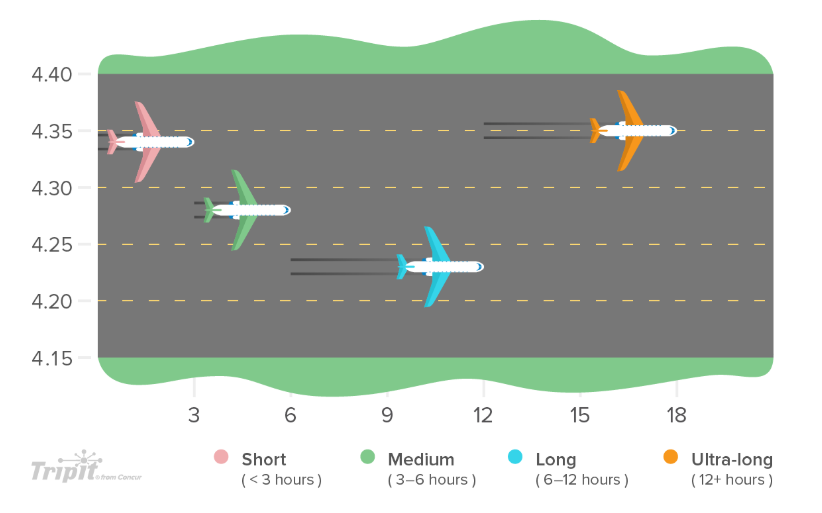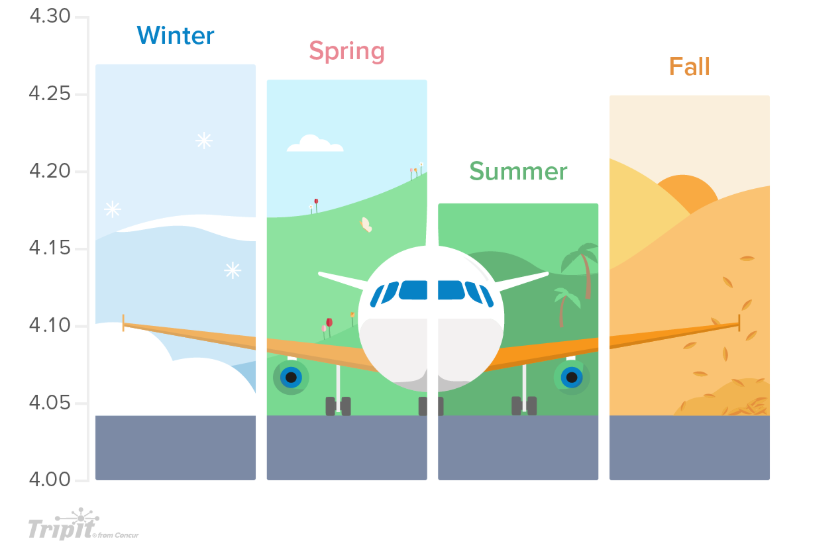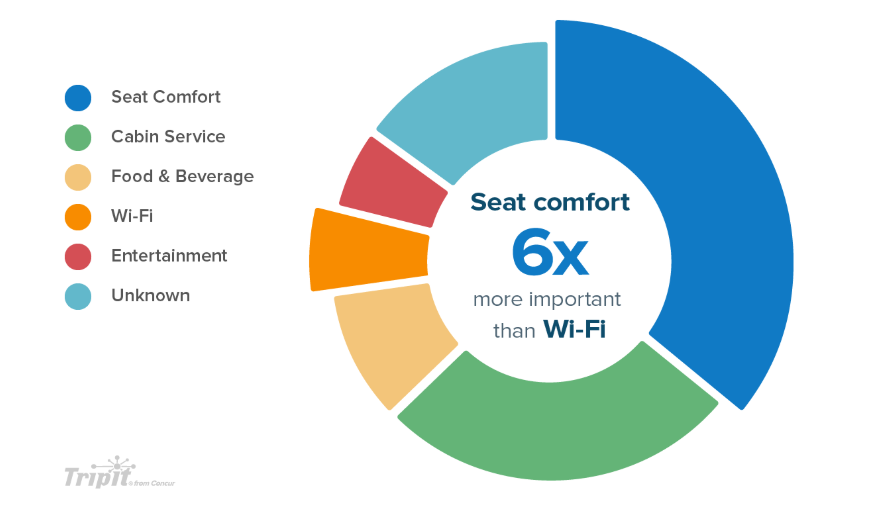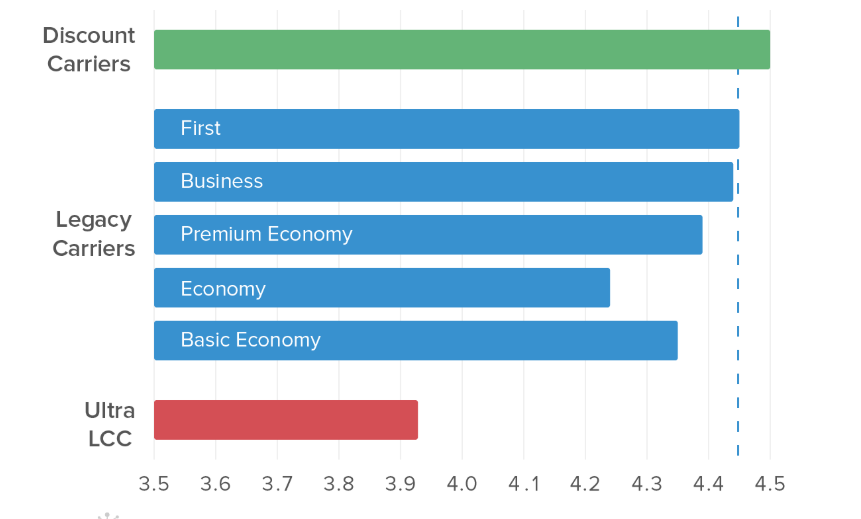There is obviously not a one size fits all mentality when it comes to flying, but popular online travel planner, TripIt, has attempted to find what the most important things are to air travellers and what they expect during the journey. The latest third instalment of its annual 'Happy Travellers Report' looks at what actually makes American travellers happy when they take to the skies.
This year, TripIt analysed more than a million flight ratings (1- to 5-star scale) between Jun-2018 and Jun-2019 to understand which factors most impact flyer happiness.. From departure season, to ticket type, to flight duration, to amenities, it generalises that when it comes to flyer happiness, it's all about meeting (and beating) traveller expectations.
"The preconceived expectations of flyers are as personal as the travel plans they make. And all of the touch-points along the way - from departure airport to in-flight service to final destination - can make or break flyer happiness," it explains.
Its key findings included that time is arguably the most important commodity for travellers, even more so than ticket price. But there is a clear difference between time and duration according to its analysis of US travel.
It's no surprise that short-haul flights (less than three hours) rank high in its traveller-reported satisfaction, averaging 4.34 out of 5 stars. But what is surprising is the fact that ultra-long-haul flights (clocking in at more than 12 hours) actually rank nominally higher with a 4.35-star average.

Indeed, its ranking of the top three highest-rated US-origin international flights aren't short hops to the Caribbean, exploring the Americas, our across the Atlantic, rather they are ultra-long flights. The highest rating is the 17-hour+ flight from Dallas, Texas, to Sydney, Australia. Averaging 4.6 stars, this rates 9% higher than average of 4.22 for all US-origin international flights.
"Whether it is higher quality entertainment systems or better meals or just a happier crew, ultra-long-haul flying does come with some benefits compared to the shorter hops more commonly seen," says the report.
After the Dallas-Sydney city pair, New York-Dubai is ranked second (Rating=4.57), Chicago-Tokyo is third (Rating=4.56), Boston-Munich is fourth (Rating=4.55) and Los Angeles-Taipei is ranked fifth (Rating=4.52). The rest of the top ten comprises, New York-San Juan, Los Angeles-Tokyo, Atlanta-San Juan, San Francisco-Auckland, and Los Angeles-Auckland.
Trip duration isn't the only time-related factor, though, claims TripIt. The time of the year flyers take off also affects reported happiness. The season most likely to see happy frequent flyers is not the bright summer months that you would expect, but is January, when perhaps start-of-the-year optimism is at its height and airports (and flights) are less busy.
The report highlights significant variation in happiness between months of travel with January travellers rating their flights more than a third (39%) higher than travellers in June.

When it comes to flyer happiness, amenities can also make or break a flight, says the report. We now live in a commoditised travel environment and our fare type more than ever dictates what comfort and entities we have. Having all charted the baggage entitlements, whilst onboard an aircraft it is all about service and comfort, according to the TripIt findings.
Seat comfort was found to be six times more important to travellers than high quality Wi-Fi and entertainment (which data shows travellers really desire). Similarly, good cabin service was ranked 2.7 times more important than the quality of the food or beverages themselves.

Perceptions obviously also differ by ticket price and cabin of travel. It is no surprise that first class travellers rated flights much higher than passengers down the back of the aircraft. Turning left on boarding and enjoying the comfort of lie-flat seats, one-of-a-kind amenity kits, designer sleepwear, and restaurant like meals is sure to make you happy.
However, on the other side it appears that if you know you are not going to get any frills when flying then you pre conceived perceptions set you up for a better experience. The TripIt analysis shows that travellers flying basic economy were generally happier with their flight (Rating= 4.35) than those flying regular economy (Rating=4.24). Similarly, discount carriers beat all other cabin types among the legacy carriers, with a score of 4.5 stars.

It appears that travellers who fly in basic economy or with discount carriers have pre-conceived low quality perceptions for travel and therefore the quality of the service they receive - even at a basic level - generally exceeds their expectations. However, there does seem to be a big difference between LCC and ULCC carriers, which confuses this generalisation a little.
The results also highlight a preference among American travellers for smaller alternative domestic airports, again highlighting the importance of time in their travel experience. "Americans may have a reputation for super-sizing, but when it comes to domestic airports, they like to get in and out," says the report.
The analysis positions these 'alternative' airports in six of the top 10 arrival airport rankings, seven if you also include Sacramento International (SMF), which has positioned itself as an alternative to Bay Area airports). Dallas Love Field (DAL), Houston Hobby (HOU), Burbank (BUR), Oakland (OAK), Kansas City (MCI) held the top five positions in the ranking.

The report highlights that Americans may like the transactional nature of smaller, alternate airports when flying domestically, but when it comes to international airports, they prefer to be wowed. The majority of the highest-rated arrival airports "are destinations unto themselves, boasting stunning architecture, innovative technology and reputations for high-quality service," it explains. Doha (DOH) tops this list, ahead of Taipei (TPE), Tokyo (NRT), Auckland (AKL) and Tokyo (HND).